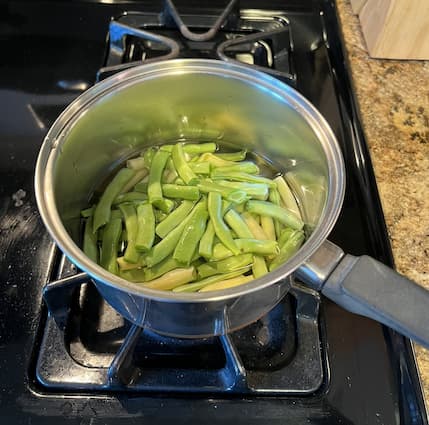Blanching Vegetables

About Blanching Vegetables
Blanching vegetables is the important first step to freezing vegetables. First, you need to know how to blanch vegetables…. it’s easy. Second, you need to identify the blanching time for each vegetable, as it varies by vegetable.
Listed below are the easy instructions to blanch your homegrown vegetables and fruits.
First, let’s answer the question “Why should I blanch my vegetables?”
Enzymes in fruits and vegetables help the fruit to grow and to mature. After you pick them, the enzymes are still in the fruit, and they continue the maturation process. If you do not kill the enzymes, the vegetables and fruit will ultimately turn overripe and tough. Sugars will be converted to starch.
Blanching kills the enzymes, stopping this process. Without blanching, frozen foods still contain active enzymes. These enzymes will continue to work, even while the food is frozen.
Note: While we speak about the enzyme effect in fruits and vegetables above, fruits are usually not blanched.
How to Blanch Vegetables
Wash vegetables, and cut them to sizes for freezing.
The blanching process starts with a big pot of boiling water.
Add a little salt, to lower the boiling temperature.
Add a small amount of vegetables.
The trick is to keep the water boiling, even after adding the vegetables.
Boil the vegetables until they just begin to soften.
There is a recommended boiling time for each vegetable. We have listed many of them below for your convenience.
Remove the vegetables with a strainer.
Immediately plunge them into ice-cold water.
As soon as the vegetables have cooled, strain them from the cold water.
Use a clean towel or wipe off excess moisture.
Place the vegetables in airtight freezer bags, mark the bags with the vegetable name and the date you froze them.
Place it in the freezer immediately.
Note: Blanching time varies by the size of the vegetable pieces.
USDA Recommended Vegetable Blanching Times (Source: USDA)
Vegetable: | Blanching time (minutes): |
| Asparagus, Small | 2 |
| Asparagus, Large | 4 |
| Beans, Regular Cut | 3 |
| Beans, French Cut | 2 |
| Beans, Lima, Small | 2 |
| Beans, Lima, Large | 4 |
| Beets, Small | 25-30 |
| Beets, Large | 45-50 |
| Broccoli | 3 |
| Brussels Sprouts, Small | 3 |
| Brussels Sprouts, Large | 5 |
| Cabbage, Minute | 1 1/2 |
| Carrots, Whole | 5 |
| Carrots, diced or sliced | 2 |
| Cauliflower | 3 |
| Corn, kernels | 4 |
| Corn on cob, small ear | 7 |
| Corn on cob, large ear | 11 |
| Collards | 3 |
| Spinach | 1 1/2 |
| Okra, small pods | 3 |
| Okra, large pods | 4 |
| Peas, small pods | 1 1/2 |
| Peas, large pods | 2 |
Household Cleaning Tip
During COVID, we all learned to disinfect door and cabinet handles. Don’t forget this hard-learned lesson. Using a cleaner with a disinfectant keeps you and your family healthier. It is especially important during winter months when colds, flu, and COVID are more common.
Additional Resources
Contribute a Recipe
Got a favorite garden recipe to share? Email it to us. Include your first name, last name (or the first initial of your last name), and where you live so we can give you proper credit and recognition. Contribute a recipe now
Please support our site. Shop for:
Thanks for reading our article on blanching vegetables. Please tell your friends about us.
- rmmatthews100@hotmail.com
- 585-721-6528
- Rochester, NY
©1999-2024 GardenersNet.Com, All Rights Reserved

